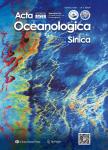Major and trace element geochemistry of the mid-Bay of Bengal surface sediments: implications for provenance
Major and trace element geochemistry of the mid-Bay of Bengal surface sediments: implications for provenance作者机构:College of Marine Geosciences Ocean University of China Key Laboratory of Marine Sedimentology and Environmental Geology The First Institute of OceanographyState Oceanic Administration Laboratory for Marine Geology Qingdao National Laboratory for Marine Science and Technology
出 版 物:《Acta Oceanologica Sinica》 (海洋学报(英文版))
年 卷 期:2017年第36卷第3期
页 面:82-90页
核心收录:
学科分类:0710[理学-生物学] 070902[理学-地球化学] 0709[理学-地质学] 07[理学] 0908[农学-水产] 0707[理学-海洋科学]
基 金:The National Natural Science Foundation of China under contract No.U1606401 the National Program on Global Change and Air-Sea Interaction of China under contract Nos GASI-02-IND-CJ02,GASI-GEOGE-03 and GASI-GEOGE-06-03
主 题:major and trace element Bay of Bengal provenance quantification factor analyses
摘 要:The major and trace elements in 110 surface sediment samples collected from the middle of the Bay of Bengal(mid-Bay of Bengal) are analyzed to investigate provenance. Si levels are highest, followed by Al, and the distributions of these two elements are identical. The average CIA*(chemical index of alteration) value is 72.07,indicating that the degree of weathering of the sediments in the study area is intermediate between those of sediments of the Himalayan and Indian rivers. Factor analyses and discrimination function analyses imply that the two main provenances are the Himalayan and the Indian continent. The inverse model calculation of the Tinormalized element ratios of the Bay of Bengal sediments indicate an estimated average contribution of 83.5%and 16.5% from the Himalayan and peninsular Indian rivers to the study area, respectively. The Himalayan source contributes more sediment to the eastern part of the study area, whereas the western part receives more sediment from the Indian Peninsula than did the eastern part. The primary mechanisms for deposition of sediments in the study area are the transport of Himalayan matter by turbidity currents and river-diluted water and the transport of Indian matter to the study area by a surface circulation in the Bay of Bengal, particularly the East India Coastal Current.



